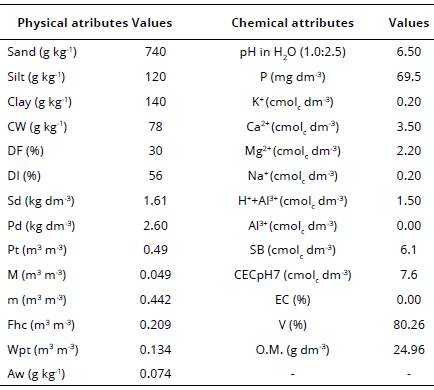Introduction
The cultivation of vegetables in Paraiba Agrest is mainly performed in soils with low content of organic matter. Moreover, they are characterized as acidic and poor in nutrients, caused in most cases by intensive agricultural use, which have the need for continued use of mineral fertilizers, mainly resulting limiting carbon content (C) over the years (Conceição et al., 2014).
Even in soils with nutrient levels considered adequate, a supply of organic material becomes necessary, it allows to enhance the chemical, physical and biological properties of the soil, resulting from the action of humic acids present and available by adding organic fertilizer. Associated to those situations soils in semiarid regions present naturally low levels of organic matter, due to weather conditions favorable to decomposition, compromising even more the viability of a successful farm, and there should have application of organic matter that can supply the nutrient requirements of crops indispensably, thus while increasing cation exchange capacity (CEC) decrease evaporation losses, and increase the water storage (Nascimento et al., 2015).
As an alternative in the supply of organic matter to the soil, has been used bovine manure (BM), due to greater availability and lower cost, because its consecutive use tends to increase soil fertility, especially nitrogen (N), phosphorus (P) and potassium (K) (Tejada et al., 2016). Studies using BM to fertilize vegetables in northeastern Brazil have been conducted and proved the beneficial effect on increasing crop productivity. For instance, in the culture of watermelon, Nascimento et al. (2015) and Nascimento et al. (2017) observed that 1.10 kg dose pit-1 of BM promoted higher productivity and the increase of BM dose reduced the need for potassium fertilizer to increase plant productivity.
In gherkin culture, Oliveira et al. (2014) observed that the doses of 26.3 and 27.7 t ha-1 of BM were responsible for the maximum commercial productivity of gherkin fruits, wherein the authors indicate that the highest values obtained with BM must be due to the larger supply of macronutrients (N, P and K). Silva et al. (2012) also observed that the BM dose of 19.2 t ha-1 gave the highest yield of 20.3 t ha-1 in commercial yam tubers.
On the other hand, stonemeal technique, a practice that allows you to provide nutrients and increase the cation exchange capacity (CEC) due to the formation of new minerals of clay during the rock change, it is another common practice in the Northeast. The technique consists of rock powder (RP) application directly into the soil, providing nutrients to the soil, moreover, it is a low cost alternative, which provide nutrients for plants in the short, medium and long term (Manning and Theodoro, 2018), and can be used to increase the quality and amount of mineral organic fertilizer raising productivity in horticultural, ensuring economy, since the use of alternative sources may reduce the intake of chemical fertilizers and minimize the environmental impacts, turning essential to the organic production system. Therefore, the objective was to evaluate the effect of different doses of manure and rock powder on growth characteristics, chlorophyll content, and physiological indices and B. oleracea production.
Material and methods
The experiment was conducted in experimental, located in the city of Bananeiras-PB, in the geographical coordinates 6°45’4’’ 35°38’0’’. According to the Kopen the climate classification is considered the typ As’ - Tropical rainy, dry summer, irregular annual rainfall distribution (1174.7 mm), with a maximum annual temperature of 27°C and a minimum of 18,8°C, averaging 22°C yearly. Meteorological data of the experimental period are shown in Figure 1.

Figure 1 Graphical representation of relative humidity, soil temperature, rainfall and average air temperature in the period from October 2014 to February 2015. Data from the weather station, EFSA, PB, 2015.
The treatments were arranged in five randomized blocks in a factorial 4 x 4 refers to the different doses of bovine manure (BM) (60, 120, 180 and 240 g pit-1) combined with rock powder (RP) doses (6, 12, 18 and 24 g pit-1). Each block is composed of three plots of 18 m long and 1 m wide, the bed is composed of six portions and each experimental plot consisted of 14 plants spaced in 0.40 x 0.40 m making a total of 1190 plants, 85 portions and 15 beds in the studied area and 4 beds were used as surrounders.
The soil of the prevailing experimental area corresponds to Yellow Oxisol of medium texture, with gently curly relief, with deep profile, well drained, with moderate moisture retention capacity and Loan clay sandy textural class. Before conducting experiment soil simple samples were collected in the experimental area (0 - 20 cm), being homogenized and processed into composite samples, subsequently performing chemical and physical characterization (Table 1).
The seedlings of B. oleracea L. var. acephala cv. Georgia were produced in cups containing substrate composed of humus (60%), sand (30%) and bovine manure (10%). During the production of seedlings carried out a simple bio-fertilizer application at 15 days after sowing, the same being used as a natural defense.
Was used the conventional soil tillage preparation with plowing and harrowing with a subsequent lifting of the beds. Holes were made with 0.20 m depth in the transplanting seedling stage at the time when the fertilizer was also performed with the incorporation of BM and RP (MB-4®) according to the proposed treatments. The BM and RP were analyzed and showed the following characteristics, as can be seen in Table 2. The RP used was of origin of the mother rock (Neoproterosoica Brasiliane s.I- Granitoids) (Santo et al., 2002) composed of 55% sand, 43% silt and 2% clay.
Table 2 Chemical analysis of bovine manure and rock powder used in the planting fertilizer of B. oleracea.
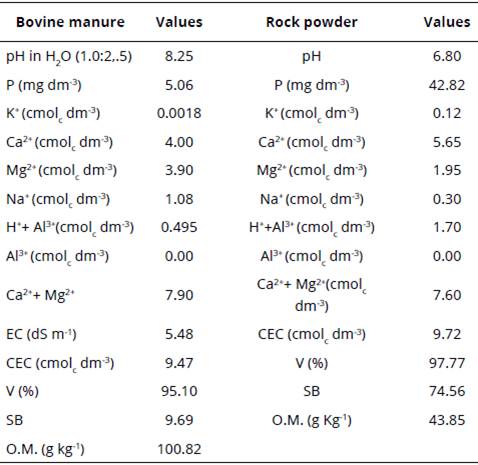
EC = electrical conductivity; CEC = cation exchange capacity; V = base saturation; SB = Sum of bases; O.M. = Organic Matter.
After transplantation and fertilization, the beds were covered with straw Brachiaria decumbens in a layer of 2 cm thick, in order to enhance the development of biological activities, control weeds, and maintain soil moisture.
The irrigation was performed by the drip system, according to the water requirements of the B. oleracea crop, adopting the 9 h irrigation shift in the initial phase and establishing the cultivation field, continuing up to 1 day in the final stage, corresponding to the last 20 days of cultivation in the field, and use of self-cleaning emitters and self-compensation with a flow of 6.0 L h-1, spaced apart 0.40 m, distributed along the line. The methodology used to calculate the irrigation was based on: Etc = Kc x ETo (crop evapotranspiration = crop coefficient x reference evapotranspiration (mm day-1).
The growth of kale was evaluated by plant height measurements, stem diameter, leaf number and leaf area at 8, 15, 22, 29, 36, 43, 50 and 57 days after transplanting (DAT), length root system and productivity at 57 days after transplanting.
Physiological parameters were assessed at 57 DAT by determining the carbon internal concentration (Ci), stomatal conductance (gs), transpiration (E), net photosynthetic rate (A), the instantaneous efficiency in the use of water, calculated by relating it to the net photosynthesis to transpiration and instantaneous carboxylation efficiency (EiC - A/Ci) from the net photosynthetic rate and the internal concentration of carbon, using infrared gas analyzer (IRGA) + LCpro system model.
Also were evaluated the levels of leaf chlorophyll a, b and total through Clorofilog® chlorophyll (Falker), every 15 days after transplantation in the field. Readings were taken at intermediate leaves of four central plants from the experimental area between 08:00 and 10:00 hours, performing four readings by plants and was analyzed as average data.
The results were subjected to the variance analysis with ‘F’ test, evaluated by comparison of means by Tukey’s test at up to 5% probability and by polynomial regression using the statistical software SAS® 9.2.
Results and discussion
The height of the plants was evaluated at different growth stages presenting significant effect for the interaction of bovine manure (BM) doses and RP to only at 8 (Figure 2A) and 15 (Figure 2B) days after transplanting (DAT) in the field. In others evaluations periods, the rock poder and BM did not differ one to another.
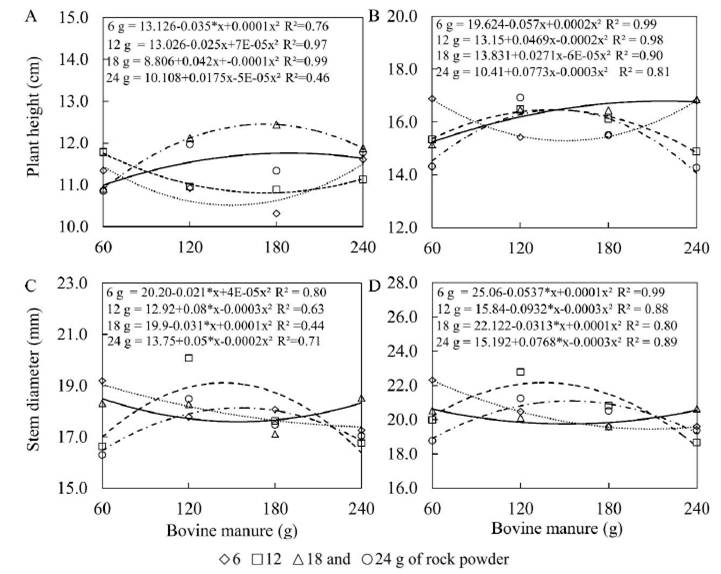
Figure 2 Height of B. oleracea at 8 DAT (A) and 15 DAT (B), stem diameter at 50 DAT (c) and 57 DAT (D) under the effect of bovine manure and rock poder
At 8 DAT the treatment that influenced initial development of B. oleracea interaction the most was 180 g of BM + 18 g of RP where plants obtained 12.4 cm height, the lowest values being observed in plants fertilized with BM 180 g + 6 g RP (Figure 2A). This limitation of the growth may be due to lower concentrations of RP present in the treatment used, which consequently may have been lower availability of nutrients to the plants, resulting in the commitment of its development in height.
At 15 DAT interaction of doses 240 g BM + 18 g of RP provided for taller plants of B. oleracea with maximum values of 16.85 cm statistically different of doses of BM 240 g + 24 g RP where lower values were observed in height, recording up to 14.26 cm (Figure 2B). The dose of 24 g of RP provided the greatest plant height, obtaining the maximum value of 16.91 cm (Figure 2B).
Possibly the largest doses of manure have provided greater levels of nutrients for plants of B. oleracea (Table 1), mainly nitrogen, which is the most important macronutrients for plants, especially at the initial stage of growth as plants absorb nitrogen actively whenever they are in the initial growth phase for the formation of cells, generating more growth in the initial phase of development (Aguilar et al., 2015).
The plant of B. oleracea at 50 (Figure 2C) and 57 (Figure 2D) days presented stem diameter of respectively 20.1 and 22.7 mm plant-1, recording the highest values when fertilized with 120 g of BM + 12 g of RP. With the reduction of organic fertilizer even associated to the maximum dose used in RP, 60 g of BM + 24 g of RP, the B. oleracea plants presented the greatest reduction in the expansion of stem diameter, and observing 16.2 and 18.7 mm plant-1, in this order at 50 and 57 DAT. The intermediate doses of BM and RP may have provided better balance in soil fertility and generated higher mineralization and solubilization of these matters, and thus a greater availability of nutrients, including nitrogen, providing greater growth in the diameter of stems of plants.
The number of leaves of B. oleracea were influenced by the interaction between doses of BM and RP only at 15 DAT (Figure 3A), which in dosages of 60g of BM + 6 g of RP reached 8.6 leaves plant-1. In comparison there was a restriction of leaf on plants fertilized with the maximum doses of 240 g fertilizer BM + 24 g of RP, just promoting the establishment of 7.2 leaves plant-1.
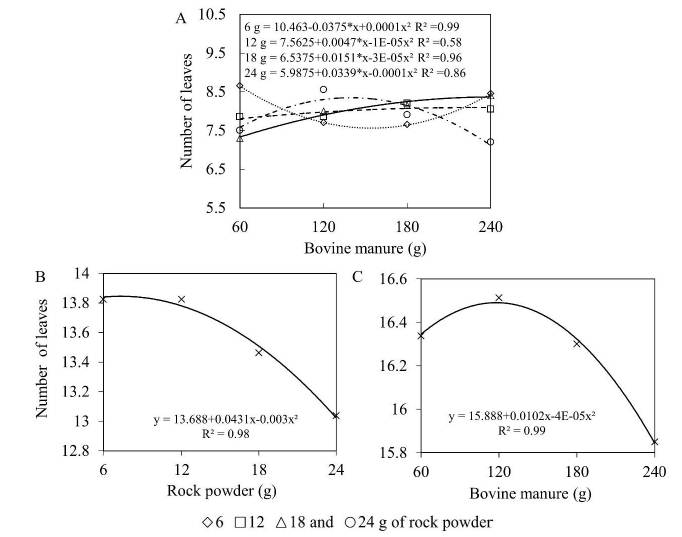
Figure 3 Number of leaves at 15 DAT (A), 29 DAT (B) and 36 DAT (C) of B. oleracea fertilized with bovine manure and doses of rock poder
Intermediate doses of cattle manure and rock dust may have provided a better balance in soil fertility and led to greater mineralization and solubilization of these issues, and thus greater nutrient availability, including nitrogen, providing greater growth in stem diameter of the B. oleracea plants. In addition, higher doses may have caused phytotoxic effect on buter kale plants (Moura et al., 2018).
The rock powder as an isolated factor influenced at 29 DAT (Figure 3B), and BM at 36 DAT (Figure 3C). In this first period, the doses of 6 and 12 g of RP showed higher number of leaves with 13.8 leaves plant-1. In the second period, the dose of BM provided reduction in the number of leaves, that way, increasing doses resuled in growth restriction, resulting in the largest number of leaves in B. oleracea plants fertilized with 60 g of BM (Figure 3D).
In general, for growth variables (plant height, stem diameter, leaf number) which presented significant difference for the BM doses and RP or the interaction of these factors, the results obtained during the different growth stages can be justified in function of the mineralization process and the amount of these materials applied to the soil. The BM and RP are materials that tend to have a release of nutrients variable, affecting the availability to the plants and plant characteristics. In the case of BM, it has a higher relation C/N ratio when compared to other sources of fertilizer, which ends ultimately providing more slowly minerals for plants. The rock powders, the mineralization and release of the present ions are slow and gradual, they are not available in some cases in the initial phase of crop development (Tito et al., 2019).
However, when applied in appropriate associated form and in amount and particle sizes in a soil that has biological activity and chemical and physical characteristics favorable, the BM and RP can cause effects in a shorter period of time and thus to promote plant growth due to the fertilization (Osterroht, 2003). In this context, is realised that the effects on plants from the practice of fertilizing with these materials can be diverse, affecting them since the establishment phase of the field in culture to the production phase.
The results obtained for plant height, stem diameter, leaf number corroborate with those observed by Tessaro et al. (2012), analyzing agroecologic seedling production and development on field of Chinese kale using different percentages of compound (bovine manure + corn + soy+ wheat), sand and basalt powder, where the height plants obtained 46.7 to 53 cm, stem diameter 16.2 to 25.09 mm plant-1 and for leaf number from 30.8 to 52.6 plant-1.
Steiner et al. (2009) evaluated the effect of the organic compound on the production and accumulation of nutrients in the leaves of B. oleracea , also observed results for stem diameter variables in function of leaf number in function of alternative fertilizing used, where for these variables were influenced and obtained stem diameter of 16.2 mm to 22 mm and exhibiting 18.8 leaves plant-1.
The leaf area was significantly affected by interactions of BM dosages and RP doses, where plants grown at doses 120 g of BM + 18 g of RP had greater leaf area up to 594 cm2 plant-1 (Figure 4A), the lowest leaf area of 403 cm2 plant-1 was observed in the plants fertilized with doses of BM 180 g + 24 g of RP. It is possible that the response of leaf area to fertilizer applied at intermediate doses is due to the effect of fertilization in a balanced way in the development of culture.
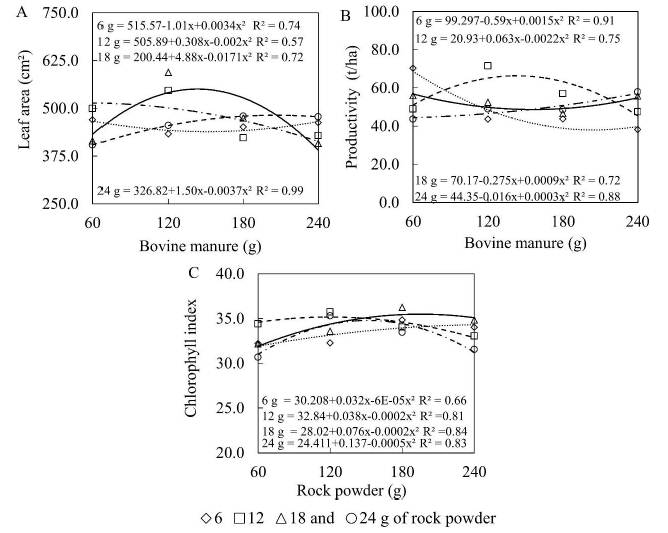
Figure 4 Leaf area (A), yield (B) and chlorophyll content (C) in the B. oleracea, depending on bovine manure and rock powder
The interaction of doses of BM and RP also affect the productivity of B. oleracea plants, verifying expression between plants cultivated with doses 120 g of BM + 12 g of RP (70 t h-1) and treatments with lower yields 120 g of BM + 6 g of RP (43 625 t h-1), 180 g of BM + 6 g of RP (43.750 t h-1) and 240 g of BM + 6 g RP (38.187 t h-1).
The manure used as a source of organic fertilizer had C:N relation of 18/1 being considered optimal mineralization (Schroder et al., 2013). After incorporation of the BM into the soil, the mineralization process is activated by the microorganisms, allowing the release of these nutrients in its mineral form to the soil solution, being able to be absorbed by the plant root system and thus increase the productivity of B. oleracea. Thus, the gradual mineralization of bovine manure and solubilization of rock powder added to the soil may have allowed the supply of nutrients that were at low levels in the soil until appropriate levels, thereby generating an increase in productivity B. oleracea (Camargo et al., 2012).
Camargo et al. (2012) when took BM doses (0 to 100 t ha-1) test and of basalt powder dose (0 to 6 t ha-1) in the strawberry productivity, also achieved significant results. The evaluated fruits outperformed the association with higher doses of BM with intermediate doses of basalt powder. Even for the variable productivity.
Considering the behavior observed in Figure 4, can be attributed to the supply of BM has increased the absorption of macronutrients by B. oleracea plants, contributing to increased productivity since with the addition of organic matter there is increase of CEC, improvement of soil physical structure, factors that are crucial to keep the cationic nutrients such as K in the root absorption zone (Nascimento et al., 2015).
As observed in this study, use of organic sources such as BM and RP positively influence the B. oleracea. In semiarid regions, the use of alternative fertilizer is extremely important, since in these regions soil organic matter is oxidized rapidly due to high temperatures. Thus, in semi arid regions, the cultivation of vegetables such as B. oleracea and other crops requires periodic replacement of the soil matters via manure (Medeiros et al., 2017).
Observing the Table 3 and can be verified that higher doses of BM promoted higher internal CO2 concentration (Ci), net photosynthetic rate (A), stomatal conductance (gs), leaf transpiration (E) and instantaneous efficiency carboxylation (EIC), however, the higher water use efficiency (EiUA) was observed in B. oleracea plants fertilized with 60 g of BM.
Table 3 Medium relating to internal concentration of carbon (Ci), net photosynthetic rate (A), stomatal conductance (gs), transpiration (E), instantaneous efficiency in the use of water (EiUA - A/E) and instantaneous carboxylation efficiency (EiC - A/Ci) B. oleracea plants depending on the dose of bovine manure and rock powder.
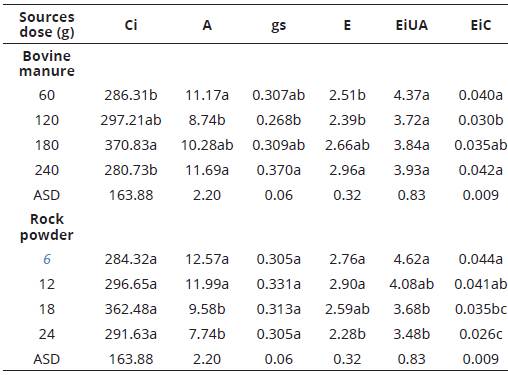
ASD = average significant difference. Means followed by the same letter in column are not different by Tukey test at 5% probability.
These results indicate that the BM also positively influence the physiological characteristics of the B. oleracea concentrations of net photosynthesis and CO2 indicate higher photosynthetic activity. The B. oleracea plant who received higher doses of BM presented the highest growth, proving that higher photosynthetic rates can be correlated with an increased stomatal opening, and thus greater absorption of CO2, providing thus higher plant growth (Koyoro et al., 2013).
In beet crop, Gondim et al. (2015)) observed that higher net photosynthesis rate (A), transpiration (E), stomatal conductance (Gs) and intercellular concentration CO2 (Ci) was obtained in plants fertilized with the higher doses of BM, similar to that seen in Table 3 for B. oleracea culture. The authors note that these results are due to the abundant supply of essential nutrients for crops growth and development.
Variations referenced in Table 3, may be due to the improvement in the physical characteristics of the soil, since the BM has a high content of organic matter, allowing greater water retention, thereby plants absorb more water, a fact evidenced by the greater stomatal conductance.
Smaller doses of rock powder provided higher net photosynthesis rate, leaf transpiration, efficiency in water use and instantaneous efficiency of carboxylation. On the other hand, although not have shown a significant difference, larger doses of rock powder tended to promote a higher concentration of CO2, however, the higher concentration of carbon in the carboxylation site was not secured by the rubisco, since the highest concentration of CO2 coincided with the reduced photosynthetic rate (Table 3).
Within the socio-economic context of agriculture in Brazil, where most low-income vegetable producers, the use of organic sources in agriculture with low purchasing value and high biological quality may be a further alternative for greater producer independence. and offering healthier foods. Thus, the fertilization of vegetables with organic sources becomes of great relevance.
Conclusion
Doses of bovine manure and rock powder 180 and 18 g, respectively, increased the growth of B. oleracea L. var. acephala by plant height, stem diameter, number of leaves;
The combination of doses bovine manure 120 g + 12 g rock powder and 120 g bovine manure + 18 g rock powder, provided, in this order, larger results for leaf area and productivity of B. oleracea L. var. acephala;
The bovine manure promotes greater concentration of CO2, net photosynthesis rate and stomatal conductance of B. oleracea L. var. acephala plant, while rock powder limits these characteristics.
Intermediate doses of bovine manure and rock powder promote higher growth and yield of B. oleracea L. var. acephala.













